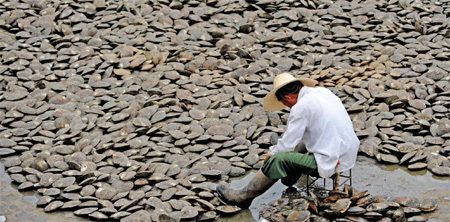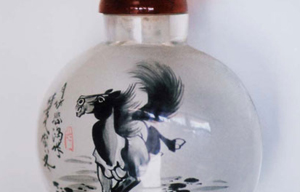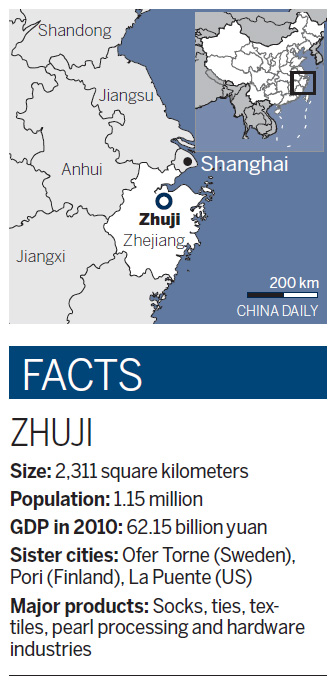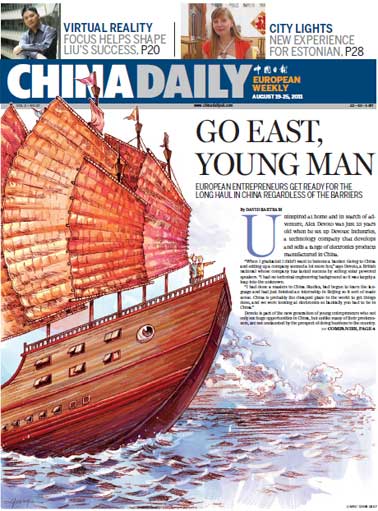Pearl paradise
Updated: 2011-09-23 08:39
By Yan Yiqi (China Daily)
|
|
Dreams of a 'crazy' man turned out to be a real pearler for city
Some of He Genmu's detractors once regarded him as crazy. If he had heeded their views, Zhuji city might have remained a small textile-manufacturing outpost barely distinguishable from many others like it in the eastern province of Zhejiang. But He soldiered on, and now, Zhuji, an hour's drive from the provincial capital, Hangzhou, is widely called the Pearl Capital.
In the 1970s He was the first person in Zhuji to experiment with the techniques of breeding freshwater pearls.
At a time when gaining such expertise could not simply be gleaned by going onto the Internet or reading a few books, He picked up the techniques of pearl breeding by gathering intelligence in the neighboring province of Jiangsu, renowned for its freshwater resources and its know-how in freshwater mussel breeding.
After two years' trial, in 1973 He's 1.4-gram pearls fetched a total of 497 yuan ($78), almost four times the average annual income of a Chinese rural worker.
He's success inspired a multitude of others in the town, and its pearl industry began to flourish.

Today Zhuji's freshwater pearl output accounts for 73 percent of the world's total, says Zhao Xinguang, secretary-general of Zhejiang Professional Association of Pearls. In the first half of this year the value of pearls produced in Zhuji was 4.3 billion yuan, 34.18 percent higher than in the previous corresponding period.
As lucrative as that may sound, the local government and companies feel that they have too little say over pricing.
The average price of Zhuji pearls was $113 a kilogram last year, and after being bought by foreign agents the price reached $800 a kilogram.
In addition, in 2008, when the world financial crisis hit, Zhuji's pearl industry was badly hit, Zhao says.
"Overseas orders dropped sharply and pearl output reached a record high in the same year. Pearl farmers suffered great losses."
After that, the local government and companies decided to cut production. In 2008 total output in Zhuji was 2,000 tons; last year it was 800 tons, and the price of Zhuji pearls has begun to rise.
Yao Jianghai, deputy chief of Shanxiahu township, where almost all pearls in Zhuji are processed and sold, says the town is considering establishing an international pearl price index that would give Zhuji a bigger say in pricing.
The widespread purchase of pearls within China is a relatively new phenomenon. It was not until the early 1990s that they began to be affordable to a large number of people, and that awareness of them as items of jewelry began to grow.
Before 2008 sales of pearls largely depended on overseas export, says Xuan Jianzhou, another deputy chief of Shanxiahu township.
"However, jewelry was not allowed for export in the early 1980s, so pearl farmers had to carry their pearls all the way to Shenzhen in southern China, in the hope that they could find a way to sell the products to overseas buyers through Hong Kong."
For a long time Hong Kong was the only overseas exit conduit for Zhuji pearls.
At that time, most of the pearls were inadequately processed, and quality varied greatly. So prices were low compared with those of saltwater pearls produced in Japan and Tahiti, Xuan says.
"Adding transport costs to that, the profitability was highly limited."
In 1985 a pearl market was set up in Shangxiahu. It sells original pearls and mussels and is considered the genesis of Zhuji as a distributor of freshwater pearls.
"When I first came to this place in 1987 it took me more than six hours to get here from Hangzhou airport," Lin Xianfu says. "At the end of a dusty road, groups of pearl farmers were carrying their pearls in plastic bags for sale, and the trade was done in the open air."
Lin was among the first businessmen to deal in Zhuji pearls, and he is now executive director of China Pearls and Jewelry International City there.
The market, set up in 2008, comprises 168,000 square meters of exhibition space, and more than 1,200 companies, foreign and domestic, have shops there.
Last year the value of trade at the market totaled 7 billion yuan, and Lin predicts the figure will be more than 10 billion yuan this year.
The plan is for other categories of jewelry such as diamonds and jade to be sold there, he says.
"The total investment in this market is 3 billion yuan, and many people questioned the need for such an entity because they think e-commerce will soon dominate the industry.
"(But) for jewelry with prices in the five and six digits a physical market is a must. People need to see and touch the real products before they pay the money."
The market attracts overseas buyers who not only look at and buy pearls there, but who also build factories nearby.
Mikhail Solovyov, a Russian jewelry dealer, is one of those whose company has a processing plant in the town.
"After we buy locally we send the pearls to the factory here for processing. Then they are sent to our clients, greatly reducing our costs."
More and more foreign buyers are doing something similar, Lin says, and this may be exactly what the local government is hoping for.
"The pearl industry is far more than a pillar industry to us; it is what we live on," Xuan says.
In the 42.6 square kilometer area of the Shanxiahu township, more than 80 percent of the residents are in jobs related to the pearl industry, and more than 85 percent of its total income is from the industry.
"It is a good thing that more and more local companies are building their own pearl brands, but the next step is to move out to first- and second-tier cities," Xuan says. "At that time we need to build Zhuji not only as a distribution center, but also as a pearls processing and research and development center."
|
|
This is but one of many actions being taken to give a fillip to the industry.
One company, Zhejiang Grace Pearl Jewelry Co Ltd, looking to cut labor costs, has spent five years developing an automated system for classifying pearls.
For decades such work has depended on human hands and eyes to gauge size, roundness and color, all key elements in the quality of a pearl.
The machine, said to be 95 percent accurate, can classify 60 kg of pearls in the range of 6 to 14 millimeters a day, doing away with the need for 15 workers.
The company has applied for patents on the technology and hopes to cash in on its investment by selling the machinery worldwide.
"It marks the great transition of the pearl industry from labor-intensive to technique-intensive," says Sun Fengmin, secretary-general of Gems and Jewelry Trade Association of China.
"We foresee a technology revolution in processing in this industry."
The company is also looking at setting up facilities for customers to authenticate and evaluate pearls they have bought, says Zhan Weijian, chief executive of Grace Pearl.
The company is noted for its research and development, and it uses more than 5 percent of its nine-digit sales in that area.
"Foreigners have this stereotype view that Chinese products are cheap, and that pearls are no exception," Zhan says.
"Although our prices are lower, the technology invested in those products is in no way inferior to that found in Western pearls."
Many pearl dealers in Zhuji, keen to leave no mussel shell unturned and to spare nothing from profitless waste, have started to develop by-products of pearls and mussels. These include wall decorations made from mussel shells, mussel meat turned into health beverages, and even underwear made of pearl fabric.
"Everything of the mussels should be developed into valuable products," says Zhao of Zhejiang Professional Association of Pearls.
(China Daily 09/23/2011 page12)
E-paper

The snuff of dreams
Chinese collectors have discovered the value of beautiful bottles
Pearl paradise
Power of profit
Literary beacon
Specials

Let them eat cake
Cambridge University graduate develops thriving business selling cupcakes

A case is laid to rest
In 1937, a young woman'S body was found in beijing. paul french went searching for her killer

Banking on change
Leading economist says china must transform its growth model soon


